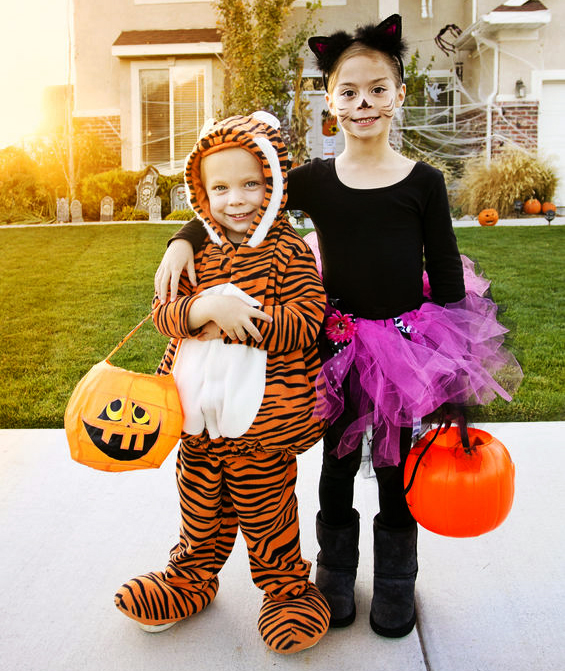Posts Tagged ‘“Halloween safety”’
Halloween Safety: Trick-or-Treat Safety Tips
 Many of us are looking forward to the ghosts, goblins and treats of Halloween this weekend. But while a lot of fun, Halloween is also one of the most dangerous days of the year for pedestrians, particularly children. The National Highway Traffic Safety Administration (NHTSA) routinely reports that traffic accidents involving drunk drivers and pedestrians increase on Halloween.
Many of us are looking forward to the ghosts, goblins and treats of Halloween this weekend. But while a lot of fun, Halloween is also one of the most dangerous days of the year for pedestrians, particularly children. The National Highway Traffic Safety Administration (NHTSA) routinely reports that traffic accidents involving drunk drivers and pedestrians increase on Halloween.
For children, the risk of being hit by a car and killed more than doubles on Halloween, according to Safe Routes Worldwide.
We want you to have fun and to be safe on Halloween. Please read our safety tips before trick-or-treating:
1) Stay Visible to Cars. Buy neon reflective clothing for your child and yourself. This can be a vest, an arm band or reflective tape. Also carry flashlights, one per person.
2) Costume Check. Make sure your child can safely walk without tripping in their costume and see through any masks.
3) Stay With Your Child. Go trick-or-treating with your child and really pay attention as they walk from house to house. Tag along if they go with friends.
4) Remind Your Child To Stay Off The Street. You probably already tell your child this daily, but really impress this upon them again for Halloween and reward them for doing it.
5) Plan Your Halloween. Many trick-or-treaters travel between 4 p.m. and 9 p.m. This year, Halloween falls on a Saturday night, so activity may extend later and there may be more gatherings. Find out what will be happening in your community through social media or ask your local town office or neighbors. You want to know what to expect, whether you are trick-or-treating or going out to a party or weekend job.
6) Remember the Cyclists. Watch out for cyclists as you drive or take your children trick-or-treating. Pedestrians should stay on the sidewalk, even if it gets crowded, and save the side of the road for the cyclists.
7) Familiarize Yourself with the Halloween Route. If you are trick-or-treating in another neighborhood, take a drive through at night with your child beforehand, even if you are familiar with the area. Take note of where the roads are well-lit, the location of crosswalks, and how long the roads stretch.
8) Look for Crosswalks. Always cross the street at crosswalks, when available.
Reminder for Drivers. Try to get home early if you can, before the trick-or-treaters arrive or stay out until after they finish. Commit to travel slowly, put your cell phone away and do not drive under the influence of alcohol. If you plan to drink, find a designated driver or bring cab fare.
Read More
Halloween Safety and a Warning About One Candy
 Halloween is a much-anticipated night for children across Massachusetts, who are excited about dressing up as ghosts and goblins, going trick-or-treating and attending costume parties. Parents have a responsibility to protect children by talking to them beforehand about appropriate behavior and dangers to avoid. Here, the Massachusetts personal injury attorneys at Breakstone, White & Gluck of Boston offer tips to help parents and all adults keep the Halloween experience safe and fun for our youth:
Halloween is a much-anticipated night for children across Massachusetts, who are excited about dressing up as ghosts and goblins, going trick-or-treating and attending costume parties. Parents have a responsibility to protect children by talking to them beforehand about appropriate behavior and dangers to avoid. Here, the Massachusetts personal injury attorneys at Breakstone, White & Gluck of Boston offer tips to help parents and all adults keep the Halloween experience safe and fun for our youth:
- Never let young children go trick-or-treating without adult supervision.
- Take children for a test run of the trick-or-treat walking route during daytime hours.
- Remind children to look both ways before crossing the street and to utilize crosswalks when possible.
- Parents and children should always walk on sidewalks.
- Children should carry flashlights or glow sticks and wear reflective tape.
- Watch out for trick-or-treaters! Drive below the speed limit in residential areas and do not pass stopped vehicles in the roadway.
- Inspect treats before consumption. Discard all homemade goods and candy that poses a choking hazard.
- At your home, leave candles, pumpkins and lanterns in a place where no one can trip and injure themselves.
- Make sure costumes are flame-resistant and will not cause children to fall or trip.
- Click here for information on safe costumes from the Consumer Product Safety Commission.
A New Warning About One Type of Halloween Candy
A new government warning issued this week caught many by surprise as families prepare for Halloween. The Food and Drug Administration (FDA) reported there is a link between black licorice and an irregular hearth rhythm. If you’re 40 or older, eating two ounces of black licorice a day for at least two weeks could land you in the hospital with an irregular heart rhythm or arrhythmia.
The FDA says black licorice contains the compound glyrrhizin, which can cause the body’s potassium levels to fall. This can trigger abnormal heart rhythms, high blood pressure, edema, lethargy and congestive heart failure.
The good news? Licorice lovers can enjoy their candy in moderation. And if you have ever enjoyed too much licorice and experienced health problems, they are unlikely to reoccur unless you once again eat more than the recommended licorice limit. The FDA says all health complications end when black licorice consumption stops.
Click here for more information about the FDA’s Oct. 25, 2011 warning about black licorice.
Read More
Keep Your Family Safe This Halloween
Halloween is just a few days away and that means it’s time to pull out the ghost and goblin costumes. But before you and your children head out to trick-or-treat, it’s worth considering a few tips for staying safe:
- Help young children choose a safe costume. Make sure it’s made out of a non-flammable material. Facial masks should provide adequate openings for breathing and vision.
- Check to see if you can incorporate reflective tape or other components into your child’s costume. If not, other accessories like glow sticks or flashlights help make your child more visible to drivers.
- Children should go out trick-or-treating with an adult. When there’s a group of children, a few adults should go along and take careful head counts throughout the night.
- Plan a safe trick-or-treating route and discuss it with your children to make it easier to find each other if you get separated.
- Give your child a cell phone so he or she can contact you if get separated.
- Designate a time to return home from trick-or-treating in case you get separated or your children go out with another family.
- Instruct your children not to eat any candy until they bring it home and it’s examined by an adult.
- Tell your children and teenagers to never ring a doorbell without being escorted by a parent and never enter a stranger’s house.
- Talk to your children about crossing the street. Even if you’re with them, children who are excited on Halloween may be eager to get across the street on their own. Tell them to look in both directions before crossing and only cross the street in a crosswalk. Equip them with a strong flashlight.

